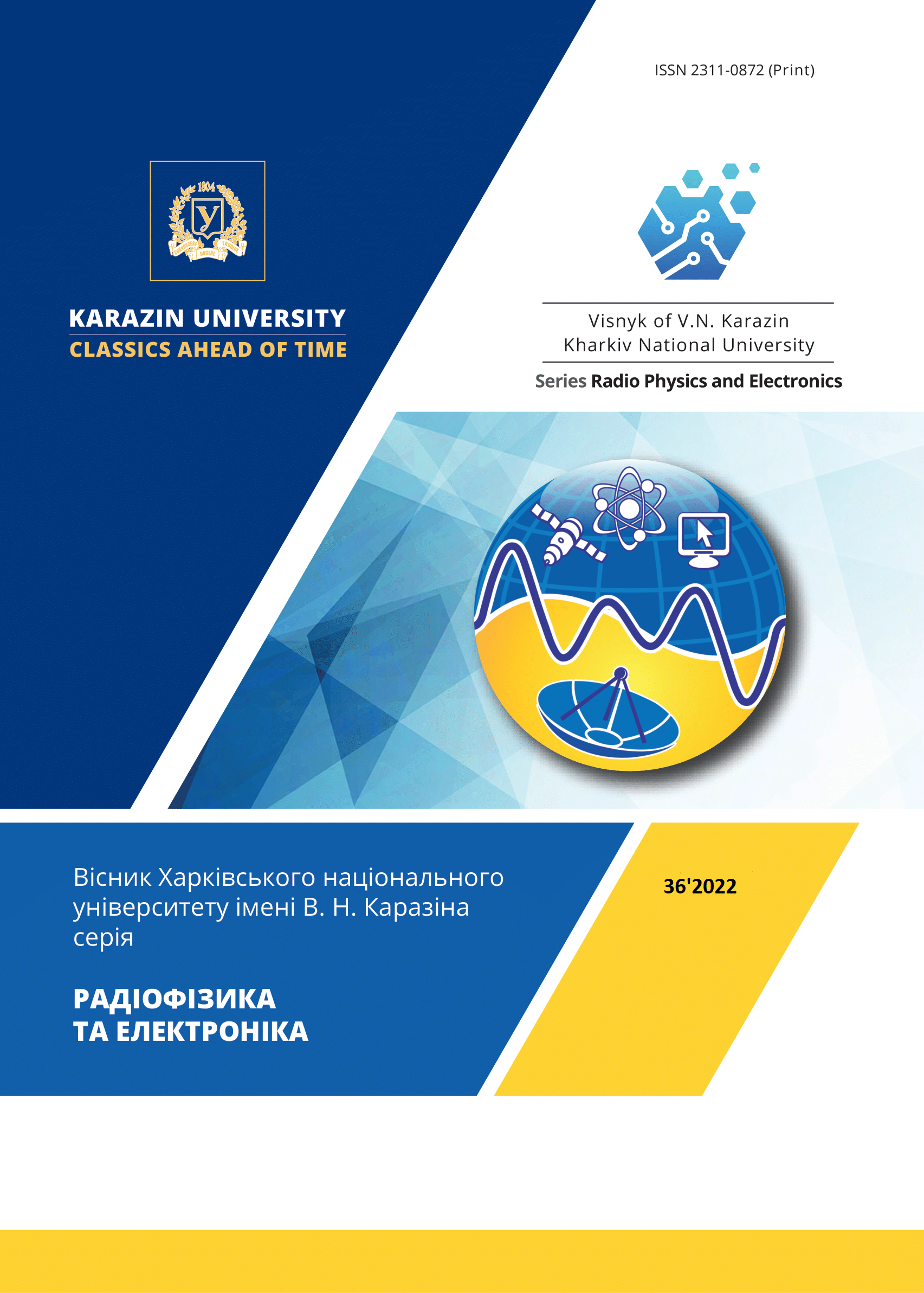Обгрунтування методу редукції при застосуванні методу нульового поля
Анотація
Актуальність. Актуальність сформульованого завдання обумовлена, насамперед, прогресом у галузі обчислювальної техніки та зростанням потужності сучасних персональних комп'ютерів. Це значно поширює клас чисельно-аналітичних методів, які можна використовувати в процессі побудови алгоритмів обробки даних в режимі реального часу. Для підвищення ефективності використання сучасного діагностичного обладнання необхідні подальші дослідження таких фундаментальних явищ природи як дифракція та розсіювання монохроматичних електромагнітних хвиль та імпульсних сигналів на об'єктах різної форми та з різними електрофізичними властивостями, а також сигналів різного поляризаційного стану.
Мета роботи – дослідження фізичних закономірностей дифракції та розсіювання монохроматичних електромагнітних хвиль та імпульсних сигналів на об'єктах різної форми та з різними електрофізичними властивостями, розташованих у тому числі й у плоскослоїстих середовищах, розвиток методів вирішення відповідних електродинамічних завдань.
Матеріали та методи. Для моделювання та дослідження поширення та дифракції гармонійних та надширокосмугових електродинамічних сигналів у даній роботі застосовується суворий метод нульового поля, який ґрунтується на зведенні граничного завдання для рівнянь Максвелла до набору інтегро-диференціальних рівнянь та подальшої побудови алгоритму розв'язання задачі за допомогою проекційної схеми.
Результати - отримано узагальнення способу нульового поля на вирішення завдань поширення полів точкових джерел (нитка електричного чи магнітного струму) в плоскослоистых середовищах з двовимірними неоднорідностями; – запропоновано розвиток алгоритмів моделювання поширення надширокосмугових імпульсних сигналів у плоскошарових середовищах з циліндричними включеннями, що спираються на розкладання вихідних сигналів до рядів Фур'є. Результати роботи знайшли відображення у двох нормативних документах: – Р В. 2.3-218-02071168-781:2011 Рекомендації щодо визначення товщини конструктивних шарів існуючого дорожнього одягу; – М 218-02071168-705:2012 Методика дефектоскопії шарів дорожнього одягу методами підповерхневого зондування.
Висновки. Отримані результати свідчать, що чисельно-аналітичні методи сучасної електродинаміки є ефективним інструментом вирішення ряду важливих прикладних завдань, у тому числі задач неруйнівного контролю. У достатній мірі апробовані методи розв'язання двовимірних задач розсіювання електромагнітних хвиль можуть знайти застосування не тільки для вирішення проблем дефектоскопії, але й скласти основу для метрологічного забезпечення процесу вимірювань за допомогою дефектометричних комплексів та тим самим підвищення надійності вимірювань.
Завантаження
Посилання
2. Doicu A, Mishchenko MI. An overview of the null-field method. II: Convergence and numerical stability. Physics Open. 2020 Jun;3:100019. doi: https://doi.org/10.1016/j.physo.2020.100019
https://www.sciencedirect.com/science/article/pii/S2666032620300065?via%3Dihub
3. Huang H-T, Lee M-G, Li Z-C, Chiang JY. Null Field and Interior Field Methods for Laplace’s Equation in Actually Punctured Disks. Abstract and Applied Analysis. 2013;2013:1–15. doi: http://dx.doi.org/10.1155/2013/927873
4. Petrov D, Shkuratov Y, Videen G. Application of theSh-matrices method to light scattering by spheroids. Journal of Optics. 2010 Aug 23;12(9):095701. doi: https://doi.org/10.1088/2040-8978/12/9/095701
5. Batrakov DO, Batrakova AG, Golovin DV. Numerical simulation of UWB impulse response of plane layered media with 2D inclusion. 2012 6th International Conference on Ultrawideband and Ultrashort Impulse Signals. 2012 Sep; p. 153-155, doi: https://doi.org/10.1109/UWBUSIS.2012.6379763.
6. Petrov D, Shkuratov Y, Videen G. Electromagnetic wave scattering from particles of arbitrary shapes. Journal of Quantitative Spectroscopy and Radiative Transfer. 2011 Jul;112(11):1636–45. doi: http://dx.doi.org/10.1016/j.jqsrt.2011.01.036
7. Batrakov D, Golovin D. Null-Field Method Enhancement Technique for the Investigation of Scattering from Inclusions in Plane-Layered Media. 2006 International Conference on Mathematical Methods in Electromagnetic Theory. p. 507-509, doi: https://doi.org/10.1109/MMET.2006.1689837.
8. Somerville WRC, Auguié B, Le Ru EC. Simplified expressions of the T-matrix integrals for electromagnetic scattering. Optics Letters. 2011 Sep 1;36(17):3482-3484. doi: https://doi.org/10.1364/OL.36.003482
9. Moroz A. Improvement of Mishchenko’s T-matrix code for absorbing particles. Applied Optics. 2005 Jun 10;44(17):3604-3609. doi: https://doi.org/10.1364/AO.44.003604
10. Petrov D, Shkuratov Y, Videen G. Optimized matrix inversion technique for the T-matrix method. Optics Letters. 2007 Apr 3;32(9):1168-1170. doi: https://doi.org/10.1364/OL.32.001168
11. Kahnert M, Rother T. Modeling optical properties of particles with small-scale surface roughness: combination of group theory with a perturbation approach. Optics Express. 2011 May 23;19(12):11138-11151. doi: http://dx.doi.org/10.1364/OE.19.011138
12. Null field approach to scalar diffraction I. General method. Philosophical Transactions of the Royal Society of London Series A, Mathematical and Physical Sciences. 1977 Sep 20;287(1339):45–78. doi: https://doi.org/10.1098/rsta.1977.0139
13. Doicu A, Wriedt T. Null-field method with discrete sources to electromagnetic scattering from layered scatterers. Computer Physics Communications. 2001 Aug;138(2):136–42. doi: https://doi.org/10.1016/S0010-4655(01)00202-8
14. Mishchenko MI, Travis LD. T-matrix computations of light scattering by large spheroidal particles. Optics Communications. 1994 Jun;109(1-2):16–21. doi: https://doi.org/10.1016/0030-4018(94)90731-5
15. Kyurkchan AG, Sternin BY, Shatalov VE. Singularities of continuation of wave fields. Physics-Uspekhi. 1996 Dec 31;39(12):1221–42. doi: https://doi.org/10.1070/PU1996v039n12ABEH000184




